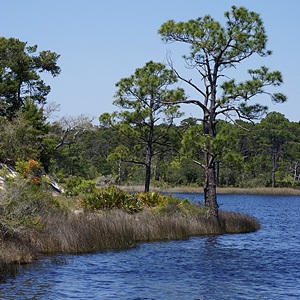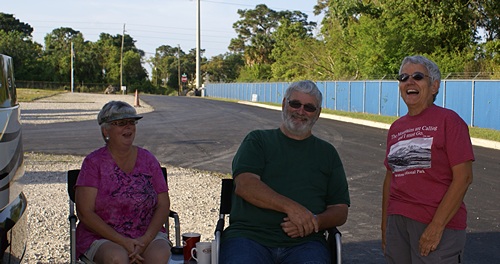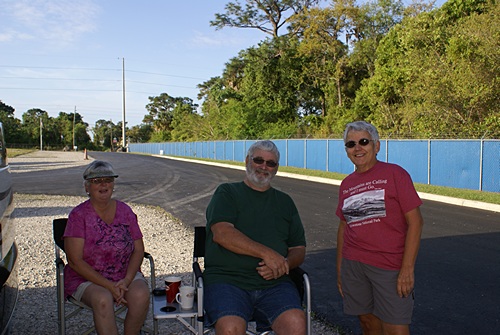As forecast, it dropped into the upper 30’s overnight. By the time we got up at 8 AM the temperature had rebounded a bit into the low-mid 40’s. I switched on the coach chassis batteries to power up the Pressure Pro TPMS and checked the pressures in all of the tires. They were all 1- 2 PSI lower than the cold pressure readings I took before we left Suncoast Designers in Hudson, even after having Tires Plus in Spring Hill add air to all of the tires. But the temperature in Hudson was in the 60’s at the time, and in the eight mile drive to Spring Hill the pressures had risen 5 – 8 PSI. How much air to add to each tire under those conditions was an educated guess at best and I had not guessed as well as I had hoped.
The DS steer tire, in particular, was reading 107 PSI this morning. My target was 110 PSI. The forecasted low for early Saturday morning is 53, and it will likely be closer to 60 degrees F by the time we pull out, so the cold tire pressures will be fine for the next leg of our journey. The issue, and the problem I was trying to solve, was to make sure we had adequate cold pressures for the colder overnight lows we may (will?) encounter as we travel north without having the tires overinflated for where we are currently traveling. The overnight lows for next week at our home are currently forecasted to be in the low-to-mid 40’s through mid-week then in the mid-to-upper 50’s. I really need to rig up a way to travel with an air compressor that is adequate for adjusting the pressure in our bus tires. We are still at the point where bus projects seem to get added to the list faster than they get checked off.
After breakfast Linda was reading, and I was reviewing, the blog posts I had put up last night for the 12th through the 15th. Between us we found a dozen errors. The Note app on my iPad2 has an annoying tendency to change words in an attempt to correct my mis-typing and less-than-perfect spelling. I usually catch the change, but not always. I also have a tendency to miss little words such as “we” or use “a” instead of “an” or “were” instead of “where” (or vice-a-versa). I think most of these are typing errors; I actually know when to use which word. (I even know the difference between “farther” and “further”, a distinction that seems to elude even professional journalists.) I upload my drafts to my computer and finish them in MS Word where the spelling and grammar checkers find most of these kinds of things, but introduce their own unique set of rules about what words should be used.
I logged into our WordPress site and made the corrections. I also rearranged the layout of some photos. The posts looked fine on my computer but resulted in very narrow columns of text next to left- and right-justified photos, so I centered them without text wrapping. I am still trying to figure out the optimum width for inline photos that can be left- or right-justified with text wrapped around them on an iPad. I think it is around 400 pixels, but at that size details can be difficult to see. If I center them without text wrapping, they can be up to 600 pixels wide with the theme I am using. This is not an issue with gallery posts, if course, where the limitation on the size of photographs is the how large of a data file I want to upload and store.
We left the coach around 10:30 AM. Photos from today’s outing are in a separate gallery post. Our itinerary was to head towards Panama City via US-98/Co-30/Co-30A (the Emerald Coast Parkway) and then work our way back as close to the Gulf of Mexico as possible, stopping at several state parks along the way. Before we got to Panama City we saw the sign for Camp Helen State Park and pulled in. Formerly a private retreat, and then a private vacation resort for a company in Alabama, it became a Florida State Park in 1997. Camp Helen was yet another example of the FSP system acquiring formerly private homesteads and roadside attractions and preserving them for the historical, educational, and recreational use of the public now and into the future.
Besides the buildings that survive from the resort days, the park property extends from the Gulf of Mexico through white sand dunes and scrub forest along the west edge of Phillips Inlet to the other side of US-98 were it runs along the southwest edge of Powell Lake. Powell Lake is a costal dune lake, one of the largest in Florida. Costal dune lakes are rare, found only along the northwest Gulf coast of Florida and in Australia, New Zealand, and Madagascar. A large number of different bird species have been recorded here by members of the local Audubon Society and American Bald Eagles and Osprey are often seen.
We hiked the nature trail through part of the dunes and the scrub forest which had a different mix of plant life than we have seen anywhere else. The forest included Sand Pines, whose range is limited to Florida. Unlike many other pines, the pine cones of the Sand Pine do not require fire to open and release their seeds. We did not encounter any other hikers on the trail and this was one of the nicest little hikes we have taken in a Florida State Park. Camp Helen is a little gem of a park amidst the over development of Florida’s Emerald Coast.
We put the address for St. Andrews SP into the GPS and then continued on towards Panama City Beach. East of Powell Lake US-98 gets renamed the Panama City Beach Parkway. We followed the signs to the park which took us past the Naval Support Activity facility and the Navy Diving and Salvage Training Center. St. Andrew SP is at the tip of a peninsula that forms the south side of the Grand Lagoon. Just past the tip is the entrance to St. Andrew Bay, which opens into East and West Bays, and forms the southwest edge of Panama City.
There was a costal defense battery installed at the tip during WW II to protect the bays from German submarines and one of the two gun platforms is preserved under an open-sided pavilion. We hiked along the southwest edge of St. Andrews SP Pond, a short but excellent trail. The pond, and the island in the middle of it, are home to many different birds as well as alligators, and is an egret rookery. We did not see any alligators on our hike, but we saw and heard lots of birds.
We left St. Andrews SP and followed Thomas Drive to Front Beach Road (Co-30) and followed this along the Gulf until we were forced back onto US-98 just before Western Lake and Grayton Beach SP. It was after 4 PM and we were getting a little tired but we pulled in to Grayton Beach SP to check it out because Chris and Cherie of Technomadia had rated it one of their top 10 + places to camp. The campground was fully booked, but we were able to drive through and agreed that it looked like a charming place to put down the leveling jacks (if only we had some and if only we could have gotten a reservation). Continuing west on US-98 we spotted the entrance to Deer Lake SP and pulled in. The entrance road was in bad shape, one of the few times we have encountered this at a Florida State Park. It led to a small parking lot that was right up against some large fancy housing on the east property boundary. All of the park lay to the west and was only accessible by hiking. It was probably lovely, but we were hiked out for the day. We switched drivers and headed back to our RV park.
We got back to the coach around 5 PM. I dumped the waste tanks and filled the fresh water tank while Linda got dinner ready. We had skipped lunch today, so we were hungry. She made a simple green salad with a balsamic vinaigrette dressing and seasoned couscous to go with the left over Tofurkey roast and steamed green beans. A glass of moscato and some fresh pineapple chunks for dessert completed the meal.


